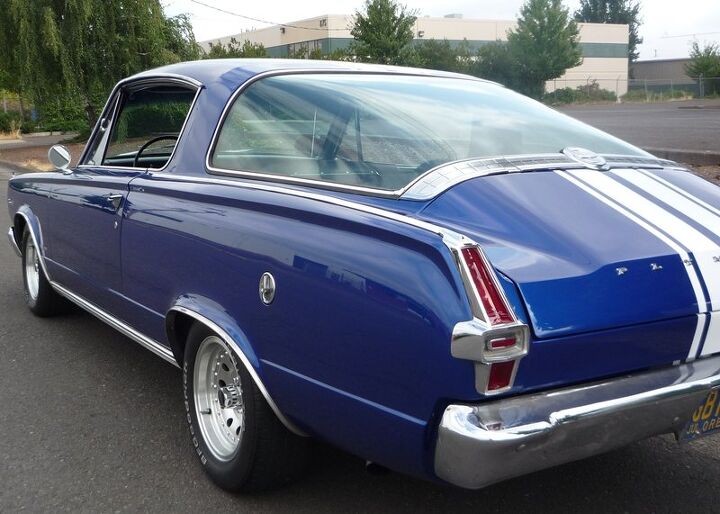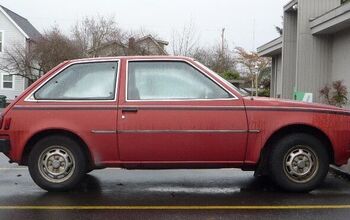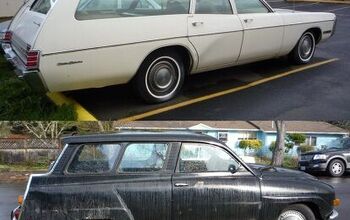Curbside Classic: 1966 Plymouth Barracuda

Pity the poor Barracuda. It beat the Mustang to market in 1964 by 16 days, but was utterly trounced by that seminal (and genre name-giving) pony car. In their first full year (1965), the Mustang outsold the ‘Cuda by 9 to 1. Well, despite that huge glassy fastback, it was hard to fool anyone that the Barracuda was anything other than a Valiant Signet with a fishbowl grafted on. That hardly made it an inferior car per se, and the fold down rear seat and resulting flat floor made it highly practical for certain uses. But the distinctive long-hood short-deck proportions of the Mustang instantly became iconic and a must-have; a glass-back Valiant just wasn’t going to do the trick, unless of course you found yourself in the right position to fully appreciate the Barracuda’s unique qualities.
The idea for what became the Barracuda had been tossed around in various forms at Chrysler for years ( didn’t all of them?) But when word of the Mustang’s development was out, a project to compete was put into overdrive. And contrary to what might be assumed, the rear glass idea didn’t originate with the 1963 Corvette, but with some styling concepts for a proposed Super Sports Fury Coupe for the still-born 1962 models, that were never built due to the disastrous last-minute downsizing. I can’t find a picture of the fastback clays, but one can see a hint of the the direction even in the production 1960 Valiant rear window.
The Barracuda’s rear window was the biggest piece of automotive glass (14.4 sq.ft.) produced to date. Combined with the fold down seat and the opening hatch into the “trunk”, a seven foot long cargo area was available. And since the Barracuda had the same upright seating dimensions as the Valiant, it was a (semi) legitimate five seater; certainly much more so than the Mustang.That led to the Barracuda being marketed as much for its practical purposes as its sporty pretensions.
To start with, its sporty aspirations were fairly modest: a choice of slant sixes or the new 273 cubic inch LA V8 that put out 180 hp. That already was less than the Mustang’s 200 hp 289 base V8, never mind the 225 and 271 hp versions. For 1965, that was partly rectified with the Formula S package that included a 235 hp four-barrel version of the 273, along with suspension and steering ratio upgrades. A substantial improvement, and the ultimate A body setup for that generation, but still not exactly what it would take to get someone’s eyes off a Mustang GT.
The 1966 Barracuda had a new squared-off front end, which was mostly shared with the Valiant again. Other than that, there wasn’t too much new, except that sales slumped even further: now the ‘Stang outsold the ‘Cuda 16 to 1! A new Barracuda arrived in 1967, still sharing the new-for ’67 Valiant architecture and high cowl, but with at least its own unique sheet metal. It also came in two distinct hardtop styles, a (less glassy) but handsome fastback, and a rather unusual coupe with a roof line that evoked more than a bit of a gen1 Corvair coupe.
The ’67 Barracuda, in Formula S form, finally came into its own as a renowned performance machine thanks to its handling, now considered the best of the pony cars. That is, if one could put up with the little 273, and resist the optional and heavy 383 that was being shoehorned in as an option. The fit was so tight, power steering wasn’t even available. Big blocks in pony cars were great for the strip, but the heavy metal on their compact front ends created inevitable results in handling.
In 1968, that was resolved in a most satisfactory manner: the superb new 340 LA V8, which was no heavier than the 273. With its excellent breathing, it was underrated at an insurance -friendly 275 hp. The 1968 -1969 340 Barracuda S was the most balanced all-round performing car in its class. Of course, a cheaper Dart Swinger 340 was essentially the same thing.
The spacious rear compartment made for lots of creative possibilities. One of them was to put a blown hemi under it, creating one of the seminal wheelie-mobiles, the aptly named Hemi Under Glass (“A Rolling Research Laboratory”). Well, I never got to experience that stand-up creation, but I do have a very vivid and sweet Barracuda memory. And it has nothing to do with its handling or performance prowess. In fact, it probably wouldn’t have ever happened in a Mustang or Camaro, thanks to the Barracuda’s rugged and practical Valiant origins and that seven foot cargo area.
Feel free to jump a couple of paragraphs ahead ahead if you’re sick of my hitch-hiking stories. It was 1972, I was nineteen, and returning to Iowa after a several months-long thumbing trip up the West Coast. I got picked up in Cheyenne by three college kids in a ’65 Barracuda, late in the day, and they offered to put me up. I hit it off with the sweet young driver of the plain hand-me-down slant six automatic ‘Cuda, anything but a sporty car, and spent a few days with them. She suggested a camping trip (for the two of us) into the rugged high country to some geographic feature, which I only vaguely remember.
She had a dog, a brown medium sized mutt of particularly calm demeanor. I soon found out why: it demanded to be “run” for miles on end, following the Barracuda down the rugged gravel and dirt roads. I vividly remember looking back through that window, seeing it running along behind for miles on end, while we bounced along the rocky rough roads. The purring slant six instilled the highest degree of confidence as we headed up into the rugged hills. And the tough suspension was up to anything Wyoming could dish out, even way back in Marlboro Country.
It was already well into May, but the weather was getting colder and cloudier by the mile. We didn’t see another car all day. By by the time we got to our destination, it was drizzling and close to freezing. I have a vague memory of heating something in a can over a fire (Chef Boyardee, most likely). We quickly cleared out that seven foot long cargo area and kept each other warm back there, as well as watching the rain turn into snow as the flakes swirled down and collected on that big glass pane. And by the next morning, that window was solid white, under a couple of inches of fresh snowfall. Love under glass beats hemi under glass any day in my book, especially in that setting.
Back to the present: this ’66 Barracuda has obviously been well attended to, and probably isn’t used as an impromptu camper in the Cascades. Its also not exactly typical CC fare. But I missed out on shooting a raggedy ’65 that a tenant had sitting in her driveway; it went away just before I started hunting old cars. So this nicely restored one will have to do, as old Barracudas aren’t exactly so common anymore on streets, even in that time-warp of Eugene.
It has the original 180 hp two-barrel 273, automatic, and no power steering; an interesting combination. It seems to me that that slush boxes usually tended to come with slush steering, and sticks more likely had manual steering. Someone probably ordered it this way, maybe a former thrifty Valiant driver looking more for a practical rear “cargo area” than a cramped Mustang. The Barracuda may not have been a sales success, but I’m glad Chrysler decided to make it nevertheless. The back seat of a Mustang would have been a bitch on that long, cold night in the mountains of Wyoming.

More by Paul Niedermeyer
Latest Car Reviews
Read moreLatest Product Reviews
Read moreRecent Comments
- Tassos Jong-iL Not all martyrs see divinity, but at least you tried.
- ChristianWimmer My girlfriend has a BMW i3S. She has no garage. Her car parks on the street in front of her apartment throughout the year. The closest charging station in her neighborhood is about 1 kilometer away. She has no EV-charging at work.When her charge is low and she’s on the way home, she will visit that closest 1 km away charger (which can charge two cars) , park her car there (if it’s not occupied) and then she has two hours time to charge her car before she is by law required to move. After hooking up her car to the charger, she has to walk that 1 km home and go back in 2 hours. It’s not practical for sure and she does find it annoying.Her daily trip to work is about 8 km. The 225 km range of her BMW i3S will last her for a week or two and that’s fine for her. I would never be able to handle this “stress”. I prefer pulling up to a gas station, spend barely 2 minutes filling up my small 53 liter fuel tank, pay for the gas and then manage almost 720 km range in my 25-35% thermal efficient internal combustion engine vehicle.
- Tassos Jong-iL Here in North Korea we are lucky to have any tires.
- Drnoose Tim, perhaps you should prepare for a conversation like that BEFORE you go on. The reality is, range and charging is everything, and you know that. Better luck next time!
- Buickman burn that oil!











































Comments
Join the conversation
The car pictured is a classic. I have one that is not restored in Australia. It is a 1966 factory V8 4 speed manual.Up to date nobody seems to be able to tell me how many were made and if any had the 318 cubic inch engine fitted. Shortly i will start to bring it back to new and will challenge myself to match the one pictured.Cheers
Ah memories. My first car was a 67 Cuda Formula S fastback with the 273 4bbl. Settled for the slush box as the dealer didn't have a 4spd on the lot and I didn't want to wait for one. Also no PS which was a bit of a pain with what were then "wide" redline tires. Loved that car - handled great and could outrun small block Camaros and Mustangs, other than the high performance (275HP?) 289s. Hit 112 MPH once - assuming speedo was accurate. Only problem I had with it in 4 years was rust - which was an issue for most cars up north at the time despite the dealer applied undercoating option. Still say the 67-69 models were among the nicest designs ever from Chrysler. Never was a fan of the goofy looking first generation - or the third, so ended up with a 71 Duster. Huge mistake - a POS from the get go - corresponded with the start of Chrysler's decline.